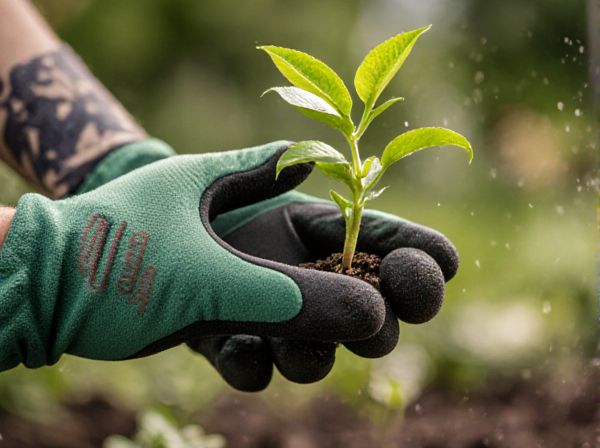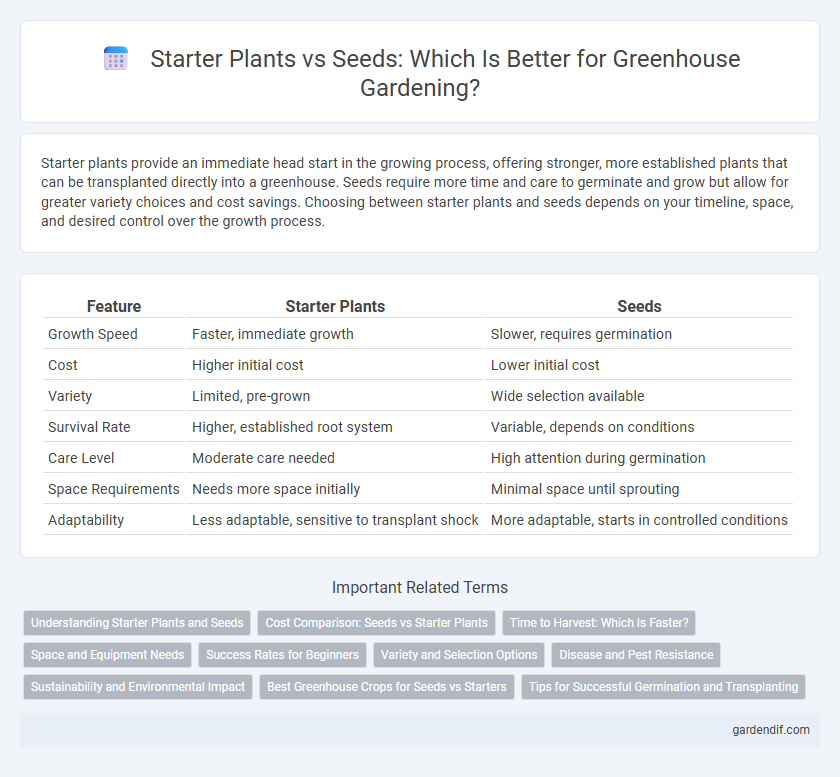
Starter Plants vs Seeds Illustration
Starter plants provide an immediate head start in the growing process, offering stronger, more established plants that can be transplanted directly into a greenhouse. Seeds require more time and care to germinate and grow but allow for greater variety choices and cost savings. Choosing between starter plants and seeds depends on your timeline, space, and desired control over the growth process.
Table of Comparison
| Feature | Starter Plants | Seeds |
|---|---|---|
| Growth Speed | Faster, immediate growth | Slower, requires germination |
| Cost | Higher initial cost | Lower initial cost |
| Variety | Limited, pre-grown | Wide selection available |
| Survival Rate | Higher, established root system | Variable, depends on conditions |
| Care Level | Moderate care needed | High attention during germination |
| Space Requirements | Needs more space initially | Minimal space until sprouting |
| Adaptability | Less adaptable, sensitive to transplant shock | More adaptable, starts in controlled conditions |
Understanding Starter Plants and Seeds
Starter plants provide an early growth advantage by offering established roots and leaves, enabling quicker transplant success compared to seeds. Seeds require precise conditions like temperature, moisture, and light to germinate, making initial care more critical but allowing for greater plant variety and cost savings. Choosing between starter plants and seeds depends on factors like desired growth speed, plant species, and greenhouse environment control.
Cost Comparison: Seeds vs Starter Plants
Starter plants generally cost more upfront than seeds, ranging from $2 to $5 per plant compared to seeds costing $0.10 to $1 per packet. While seeds require more time and care to germinate, they offer greater overall cost savings, especially when growing multiple plants. Greenhouse growers often weigh the higher immediate investment in starter plants against the long-term economy and flexibility provided by seeds.
Time to Harvest: Which Is Faster?
Starter plants significantly reduce time to harvest compared to seeds by bypassing the germination phase, allowing immediate transplanting into a greenhouse environment. Seeds require a germination period that varies from several days to weeks depending on the plant species, extending the overall cultivation timeline. Using starter plants can accelerate crop production cycles by approximately 2 to 6 weeks, optimizing greenhouse space and resource efficiency.
Space and Equipment Needs
Starter plants require less initial space and minimal equipment compared to seeds, as they bypass the fragile germination stage and provide a head start on growth. Seeds demand dedicated propagation trays, humidity domes, and consistent temperature control, occupying more space and resources during germination. Choosing starter plants streamlines greenhouse operations by reducing the need for specialized seed-starting tools and optimizing limited growing areas.
Success Rates for Beginners
Starter plants offer higher success rates for beginners due to their established root systems and quicker growth, reducing the risk of failure common with seeds. Seeds require more careful monitoring of moisture and temperature, often leading to lower germination rates without experience. Greenhouse conditions can improve seed success but still demand more attention compared to transplanting starter plants.
Variety and Selection Options
Starter plants offer immediate growth with a limited variety of hardy, disease-resistant options ideal for novice gardeners. Seeds provide an extensive selection spanning heirloom, hybrid, and exotic plants, allowing gardeners to customize their greenhouse cultivation extensively. Choosing between starter plants and seeds depends on the desired plant variety, growth control, and greenhouse environment adaptability.
Disease and Pest Resistance
Starter plants offer enhanced disease and pest resistance compared to seeds due to their early growth in controlled environments that reduce exposure to harmful pathogens. Seeds are more vulnerable to soil-borne diseases and insect infestations during germination, often requiring additional preventive treatments. Using starter plants can increase survival rates and reduce the need for chemical interventions in greenhouse cultivation.
Sustainability and Environmental Impact
Starter plants reduce water consumption and chemical use compared to seeds by minimizing the need for intensive watering and pesticides during early growth stages. Using starter plants in greenhouses also lowers the carbon footprint by shortening the cultivation period and reducing energy input for artificial lighting and climate control. Seed cultivation, though cheaper, often requires more resources and generates higher environmental impact through soil disturbance and plastic use in seed trays.
Best Greenhouse Crops for Seeds vs Starters
Starter plants provide faster initial growth and are ideal for crops like tomatoes, peppers, and herbs that benefit from early transplanting in greenhouses. Seeds offer cost efficiency and greater crop variety, especially for leafy greens, root vegetables, and flowers thriving under controlled greenhouse conditions. Selecting the best greenhouse crops depends on balancing growth speed, space, and crop type when choosing between seeds and starter plants.
Tips for Successful Germination and Transplanting
Choose high-quality seeds or vigorous starter plants to boost germination success and healthy growth. Maintain consistent moisture and temperature around 70-75degF for optimal seed sprouting, and harden off seedlings by gradually exposing them to outdoor conditions before transplanting. Use nutrient-rich soil and handle seedlings gently to minimize root disturbance during transplantation, ensuring strong establishment in the greenhouse environment.
Starter Plants vs Seeds Infographic

 gardendif.com
gardendif.com